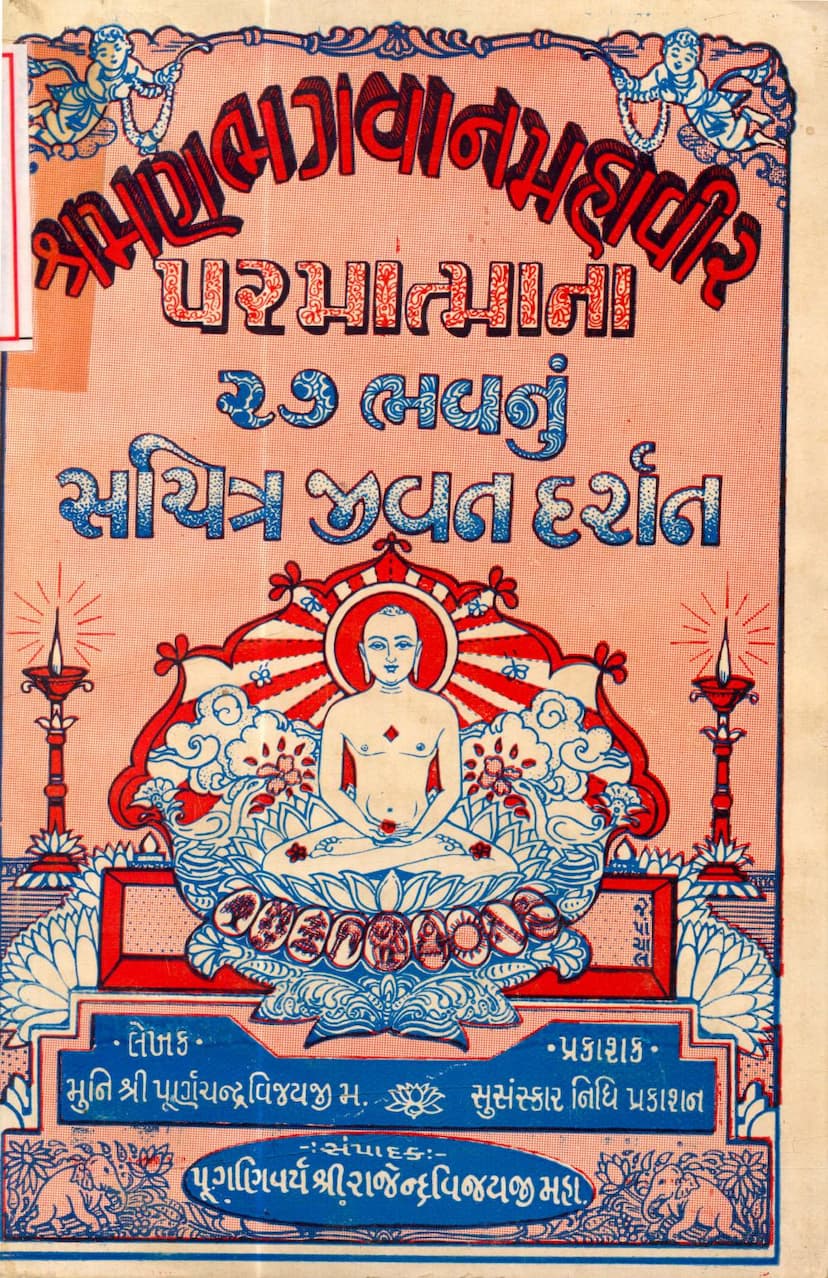Mahavir 27 Bhav Sachitra Jivan Darshan
Added to library: September 2, 2025

Summary
Here's a comprehensive summary of the Jain text "Mahavir 27 Bhav Sachitra Jivan Darshan" (Mahavir's 27 Life Episodes with Illustrations):
Book Title: Mahavir 27 Bhav Sachitra Jivan Darshan (Mahavir's 27 Life Episodes with Illustrations) Author(s): Purnachandravijay, Rajendravijay Publisher: Susanskar Nidhi Prakashan Catalog Link: https://jainqq.org/explore/022853/1
This book, "Mahavir 27 Bhav Sachitra Jivan Darshan," published by Susanskar Nidhi Prakashan and authored by Muni Purnachandravijayji Maharaj, with Muni Rajendravijayji Maharaj as the editor, provides a visually rich and narrative account of the 27 previous lives of Lord Mahavir, the 24th Tirthankar of Jainism.
Core Content:
The central theme of the book is to trace the spiritual journey and evolution of the soul that would eventually become Lord Mahavir. It details his various rebirths, highlighting the key spiritual lessons, karmic consequences, and progressive development of virtues that shaped his soul towards ultimate liberation (Moksha).
Key Aspects and Themes:
- 27 Previous Lives: The book meticulously describes 27 significant lives of the soul destined to become Lord Mahavir. Each life is presented with an illustration, providing a visual aid to the narrative.
- Spiritual Progression: The narrative emphasizes the gradual accumulation of spiritual merit, the understanding and practice of Jain principles, and the overcoming of negative karma through devotion, austerity, and ethical conduct across these many lifetimes.
- Karmic Cause and Effect: The text illustrates the Jain principle of karma, showing how actions in one life have consequences in subsequent lives. It demonstrates how seemingly small acts of kindness, devotion, or lapses in conduct have a profound impact on the soul's trajectory.
- Virtue Development: The 27 lives showcase the development of crucial virtues such as compassion, non-violence (Ahimsa), truthfulness, detachment, equanimity, and spiritual knowledge.
- Illustrative Narrative: The book uses vivid storytelling and detailed descriptions to make the past lives relatable and instructive. It connects the experiences of these lives to the eventual attainment of omnipotence and omniscience by Lord Mahavir.
- Naysar as the Beginning: The narrative begins with the life of Naysar, highlighting his pivotal moment of spiritual awakening and his initial step towards the path of righteousness, which sets the stage for Lord Mahavir's eventual birth.
- The "Susanskar Nidhi Yojana": The book is a product of the "Susanskar Nidhi Yojana" (Cultural Foundation Scheme), an initiative aimed at educating and instilling spiritual values in children through various publications, competitions, and visual aids. This project was inspired by the need to provide accurate spiritual knowledge, especially regarding the life of Lord Mahavir, to pilgrims visiting sacred sites like Bhadreshwar.
- Inspiration and Collaboration: The book highlights the inspirational role of Pujya Ganivar Shri Rajendravijayji Maharaj in guiding the project. It also acknowledges the significant contributions of individuals like Dr. U.P. Dedhiya for their efforts in bringing this publication to life, including getting the illustrations prepared and printed.
- Visual Emphasis: The use of illustrations is a crucial element, as it aims to make the abstract concepts of past lives and spiritual development more tangible and understandable, especially for younger audiences.
- Dedication and Purpose: The book is dedicated to the propagation of Jain teachings and the spiritual upliftment of individuals, particularly the younger generation, by presenting the exemplary life of Lord Mahavir.
Summary of Key Lives (Illustrative Examples based on the content):
While the text details 27 lives, some prominent examples that can be inferred from the provided snippets include:
- Naysar: A life where a moment of spiritual realization occurs, leading to the acceptance of the Namokar Mantra and a step towards the heavenly realms.
- Marichi: A life as a prince who, despite receiving spiritual guidance from his father, Lord Rishabhdev, falls prey to pride and deviates from the path of righteousness, leading to a distorted understanding of Dharma. This life is crucial as it traces the soul's initial missteps that would later require many lifetimes to rectify.
- Vishvabhuti: A prince who witnesses the consequences of worldly attachments and political machinations, leading to his renunciation and embracing of Jain monasticism.
- Triprishtha (Vasudeva): A life of immense power and influence as a Vasudeva, marked by both virtuous deeds and significant karmic pitfalls, including an instance of harming a guardian of animals (leading to a future consequence in hell) and the severe karmic consequence of pouring hot lead into the ears of a disobedient attendant.
- Ananda (Baldev): A life characterized by righteousness and devotion, contributing to a favorable rebirth.
- Nandan (Rajrishi): A significant life where the soul undertakes rigorous penance and practices the "Twentyfold Practice" (Vishsthanak), earning the karma for becoming a Tirthankar.
- Devananda and Trishala: The pivotal lives leading to the birth of Lord Mahavir. The soul descends from a heavenly realm into the womb of Devananda, a Brahmin woman, and through divine intervention, is transferred to the womb of Queen Trishala, the destined mother of Mahavir.
- Lord Mahavir's Incarnation: The book culminates with the birth, childhood, renunciation, austerities, attainment of Keval Gyan (omniscience), preaching, and eventual Nirvana of Lord Mahavir. It details significant events like the challenges posed by Sangam, Chanda Kaushik, and Shulapani Yaksha, highlighting Mahavir's unwavering equanimity, compassion, and spiritual strength in the face of adversities.
Overall Message:
The book serves as an inspirational guide for Jains, offering a profound understanding of the arduous yet ultimately rewarding path of spiritual evolution. It emphasizes that even with immense power and influence, adherence to ethical principles, compassion, and detachment are paramount for spiritual progress. The narrative of Lord Mahavir's 27 lives underscores the universal truth that through persistent spiritual effort, overcoming karmic obstacles, and cultivating virtues, any soul can ultimately achieve the highest state of liberation.